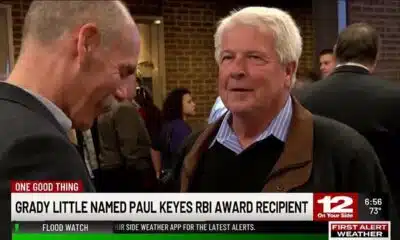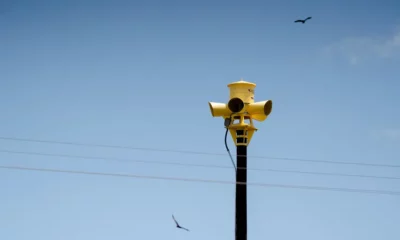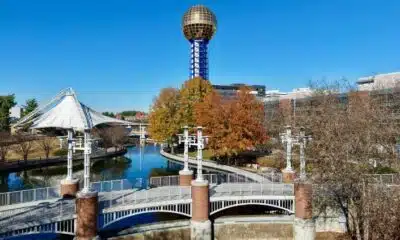News from the South - North Carolina News Feed
Redistricting reform in NC has a long history of failed attempts
Why redistricting reform fails. Why NC lawmakers keep trying. And trying.
In June 1993, Democratic state senator Clark Plexico filed a bill that would remove lawmakers’ ability to draw their own electoral maps. Instead, Plexico proposed a nonpartisan method: selecting five regular people to help draw maps during the redistricting process.
Majority and minority legislative leaders would each appoint two members. Those four would vote on their fifth and final member.
The goal was to remove politics from the decennial redrawing of maps to adjust for population shifts identified by the U.S. Census Bureau.
But the bill was never assigned a committee, and no other lawmaker signed onto it.
Three decades and 16 similar bills later, North Carolina appears no closer to a non-political redistricting process.
But that hasn’t stopped 39 House Democrats from signing onto House Bill 20 — the Fair Maps Act — this session. Upon approval by a majority of North Carolina voters, it would amend the state constitution to establish an independent redistricting commission made up of five Democrats, five Republicans and five unaffiliated voters to draw the state’s next electoral maps after the U.S. Census.
Per usual, the bill has not been assigned to a committee, meaning Republican leadership has effectively ended its run before it began.
It’s a lesson Plexico learned a long time ago: Nobody gives up power unless they’re forced. And redistricting holds the power to control a legislature, and therefore, state policy for a decade at a time.
“I was naive,” he admitted. “I thought of politics and being in elective office as public service. So I thought I was there to do the right thing, which meant: What’s the best thing for the majority of people?”
The history of redistricting reform
Plexico filed his bill when Democrats held power in both legislative chambers and the governor’s office. He was friends with leadership, too. But that didn’t stop them from asking Plexico if he was “out of his mind.”
While this type of legislation has been continuously proposed since the 1993-94 session, only four sessions saw it filed by a lawmaker who belonged to the party in power. Plexico was the first.
In the 2005-06 session, Democrat Eleanor Kinnaird tried her hand. Unsuccessfully.
Most recently, in the 2011-12 and 2013-14 sessions, Republican John Blust failed to move independent redistricting commission legislation forward even though his party held legislative control.
Nobody can successfully change the system alone, Plexico said, and they have to be willing to pay politically for the attempt.
“You can make a point, but that’s about all you’re going to do,” he said.
If passed, the Fair Maps Act would be placed on the ballot for North Carolina voters to decide whether they want an independent redistricting commission.
If they did, the process would include at least 25 public meetings of the commission. Commission applicants would have to go through the state auditor, State Ethics Commission and General Assembly before being selected. Those with political connections, including lobbyists, political donors and relatives of legislators, would be barred.
To help them draw maps, members would be trained on the guidelines and laws that inform the redistricting process, like the Voting Rights Act.
For a map to pass muster, at least nine of 15 members, and three from each party subgroup, would have to agree. If they couldn’t agree, they could hire a special master to draw districts.
So, could this be the year?
Or is this all a pipe dream?
‘Not just an ugly map’
Eight years ago, on an October morning in Asheville, runners raced along the boundary between North Carolina’s 10th and 11th Congressional Districts. They zigzagged between yards in a seemingly random route to the finish line.
They were participating in the Gerrymander 5K, a visual experiment conducted by the League of Women Voters to demonstrate how precisely lawmakers could draw maps to include — or exclude — specific streets or homes in a district for political gain.
State Rep. Lindsey Prather, D-Buncombe, said lawmakers in favor of redistricting reform need creative methods like this to educate the populace about gerrymandering and its impact if they ever want things to change.
“It’s not just an ugly map,” said Prather, who is a primary sponsor of the Fair Maps Act. “It’s not just an insider term that people like to throw around. It really changes who it is that’s representing you and how representative of a government we have.”
North Carolina has a long history of redistricting drama, going back to the late 1970s and 1980s. More recently, maps drawn by the legislature have faced a seemingly endless series of court battles for being partisan gerrymanders.
For example, there have been four maps drawn for the state since the 2020 census, and there very well could be more by the time 2030 arrives.
Independent redistricting commissions, though, might just reverse that trend. When the group creating the voting map is nonpartisan, the best ideas usually win, explained Democrat Zack Hawkins, a state senator who represents Durham.
Gerrymandered maps allow for more “extreme” ideas to see the light of day, he added. Representatives who are no longer in competitive districts don’t have to work with members of both parties to secure reelection and maintain political power.
To Hawkins, the most egregious example of gerrymandering is North Carolina’s congressional maps. Republican lawmakers took a map that had seven Democratic districts and seven Republican ones and redrew it. The new version featured 10 solid Republican districts and just four Democratic ones.
“Now, that should never be on the table for any legislature, no matter who’s in the majority, to do that because it’s not reflective of the state,” Hawkins said.
Getting closer
State Rep. Allen Buansi, a cosponsor of the Fair Maps Act, is in the business of hope.
He remembers being in law school and discussing how dangerous the redistricting process was in the hands of partisan lawmakers.
“Talking with other young people at that time, other law school students, I see the hunger for a different approach on many levels in different aspects of our society,” Buansi said.
But according to Prather, it’s an “open secret” that passing any legislation requires the support of Republican leadership. Democrats don’t have it this year, so they’re thinking more long term.
“I’m not naive,” Prather said. “I don’t think that this is necessarily going to pass this term, but I think we’re going to get closer and closer every term that we file it.”
The more lawmakers discuss the issue, Prather hopes constituents will talk to their representatives about support for the legislation.
Speaking of support, polls consistently show where the public stands on independent redistricting commissions.
“Poll after poll after poll shows that if it were on the ballot, it would pass,” said Chris Cooper, a political science professor at Western Carolina University. “People tend to like the idea of independent redistricting reform. Democrats like it a little bit more than Republicans, but both parties tend to support it.”
Ten states have some form of nonpartisan redistricting commissions. But Cooper said they have something North Carolina doesn’t: The ability of citizens to directly present an idea to the people through a ballot initiative.
“Every time it’s passed, it’s passed because the people brought it to the ballot, the people got enough signatures, and we don’t have that mechanism in our state,” Cooper said.
But Democrats aren’t giving up. And although they’ve rejected Republican attempts at redistricting reform while they were the party in power, they insist that if they’re in charge in the future, they’re committed to change.
“My party hopefully will be in the majority of the House in 2030,” Hawkins said. “And if they are, then our goal is to pass this bill.”
This article first appeared on Carolina Public Press and is republished here under a Creative Commons license.
The post Redistricting reform in NC has a long history of failed attempts appeared first on carolinapublicpress.org
News from the South - North Carolina News Feed
The North Carolinians that the “big, beautiful bill” will terrify, bankrupt, and kill
SUMMARY: President Trump’s “big, beautiful bill,” signed into law on July 4, 2025, enacts historic cuts to Medicaid and SNAP food assistance, threatening millions’ health and nutrition. Nearly 12 million Americans, including hundreds of thousands in North Carolina, face losing Medicaid coverage, with the state projected to lose \$32 billion over a decade. The cuts risk reversing recent expansions that aided vulnerable families, like Wake County’s Maddie Wertenberg, whose son’s medical costs were covered by Medicaid, and Crystal Upchurch, whose life depends on Medicaid-covered dialysis. SNAP reductions endanger food security for 1.2 million North Carolinians, intensifying hunger and poverty fears nationwide.
The post The North Carolinians that the “big, beautiful bill” will terrify, bankrupt, and kill appeared first on ncnewsline.com
News from the South - North Carolina News Feed
Locating I-40 through the Pigeon River Gorge was a bad idea, but we’re stuck with it • Asheville Watchdog
If you’re like me, you avoid driving I-40 through the Pigeon River Gorge like warm beer on a hot summer day.

Hey, if I have to circle through Georgia, Alabama, Mississippi and Arkansas to enter Tennessee from the west and then drive east back to Knoxville, I’ll do it. Perhaps I exaggerate, but that drive through the gorge to Knoxville has always been one of white knuckles, clinched orifices and prayers that speeding semis don’t topple over on you in a curve.
It’s a terrible road — windy, steep in places and remarkably prone to rockslides and landslides, as we’ve seen over the past 10 months.
Last September, Tropical Storm Helene caused the Pigeon River to swell into a raging torrent, which undermined the interstate’s lanes and caused it to shut down for five months. The NCDOT noted that the storm “washed away about 3 million cubic yards of dirt, rock and material from the side of I-40.”
It reopened with one lane in each direction March 1, but that was short-lived. Heavy rain June 18 caused a rockslide near the North Carolina-Tennessee line, and the road was closed until June 27.

These slides conjured memories for a regular correspondent of mine, who emailed me this:
“I’ve always heard that I-40 through the gorge from North Carolina to Tennessee was originally planned for a different location, but that business people in Waynesville urged that it go where it is today — despite geo-engineers concluding that route was not optimal and potentially dangerous. Is that version true, or a myth that’s seeped into local lore? Please help us all with the history and backstory of the current route, one that is creating so much consternation and harm to the region. Did it have to be designed this way?”
It’s a salient point, mainly because in the 30 years I’ve been here, slides in the gorge have been about as commonplace as someone firing up a spliff on an Asheville sidewalk.
Neither gorge nor French Broad River routes were great
Not surprisingly, much has been written about all of this, including a 2009 story I wrote for the Citizen Times in which I quoted several sources who said the Pigeon River Gorge posed known geologic problems and was prone to sliding even during construction. Jody Kuhne, a state engineering geologist with the NCDOT, provided a particularly colorful interview.

“Lots of people these days will say highway decisions are all politics — well, hell yes, they are,’” Kuehne said. “Back at that time, Haywood County had a large paper mill, major railroad access and other industry, and Madison County just didn’t have that, except some in Hot Springs. So sure, they out-politicked Madison. The road went where the action was.”
Ever since North Carolina had passed a law in 1921 stating that all counties should have a road that connects their county seat to neighboring county seats, people in Haywood had pushed for a road to the next county west, in Tennessee. Initially, the proposal was for a two-lane road, but that changed when Dwight Eisenhower became president in the 1950s and pushed for the interstate program we have today.
Haywood business leaders and politicians wanted the interstate to come their way; leaders and politicians in Buncombe and Madison counties wanted the road to follow the French Broad River where 25/70 runs today.
While many have assailed the Pigeon River Gorge as a terrible choice because of its geology, Kuehne told me in 2009 that neither route presented a good option.
“The Hot Springs-French Broad River route has crazy geologic (stuff) you can’t even wrap your mind around,” he said, explaining that it has rounded quartz rock.
It also has just as much low-to medium-grade metamorphic rock — which is more prone to slides — as the Pigeon River Gorge. In fact, 25-70 also has been prone to slides, but they don’t get noticed as much because of its lower traffic volume, Kuehne said.
I also interviewed retired NCDOT District Engineer Stan Hyatt for that story.
“I would say today, if we had no road through Haywood, with the advances in geotechnology, we would never try to build an interstate type road down there, unless there was just no place else to put it,” Hyatt said. “It’s just an area that’s full of nothing but fractured rock waiting to fall off.”

This was well known during construction and in 1968 when I-40 opened. An October 1968 Citizen-Times article quoted a Tennessee engineer who said, “It seemed like the rock and dirt had been oiled. We would blast it out, level it, ditch it, and then it would slide almost before we could get the machinery out of the way.”
The reporter noted presciently, “Engineers from both Tennessee and North Carolina said that slides would probably be a major problem along the route for many years.”
And they have been. The area has seen dozens of slides over the years, including some that shut I-40 down for months.
Was it political? Yes, no, maybe, probably…
Sussing out the politics of all this is more difficult, as they go back to the 1940s, ‘50s and ‘60s.
Adam Prince, who runs the blog Gribblenation, wrote a fine, well-footnoted piece about the gorge and I-40’s troubled history a month after Helene. He noted that, “I-40’s route through the Pigeon River Gorge dates to local political squabbles in the 1940s and a state highway law written in 1921.”
Prince wrote:
“A small note appeared in the July 28, 1945, Asheville Times. It read that the North Carolina State Highway Commission had authorized a feasibility study of a ‘…water-level road down [the] Pigeon River to the Tennessee line.’”
Prince found that a Pigeon River Gorge study, “along with a study on improving the existing US 25/70 corridor through Madison County via a water-level route along the French Broad River, was completed in late 1948.”
“The French Broad Route of US 25/70 through Marshall and Hot Springs had been the long-established travel route between Asheville and Eastern Tennessee,” Prince wrote. “Confusion on whether or not the two studies were related to each other was amplified when in December of that year, outgoing North Carolina Governor R. Gregg Cherry awarded $450,000 in surplus highway funding for the construction of the Pigeon River route.”
Construction did not follow, though, because as Prince pointed out, “it was also unknown how the route would be built.” Summer 1951 was a turning point, Prince states, as in that June “a public hearing in Asheville was held to discuss the two corridors. It was questioned if a survey of the French Broad River corridor had occurred, and the backers of that route requested another.”
In July, Gov. W. Kerr Scott awarded $500,000 toward the construction of the Pigeon River Route.
“The award cemented the eventuality of a Waynesville-to-Tennessee highway,” Prince writes. “Yet, French Broad River backers continued to push for an improved water-level US 25/70 route along that corridor.”
Two years later, the first construction project in the gorge was awarded, $1.3 million to grade 6.5 miles of “eventual roadway from the Tennessee line to Cold Springs Creek Road (Exit 7 on today’s I-40).”
Next came Eisenhower’s interstate system and lots of federal money — and more squabbling. Tennessee wanted the Haywood route, too. Prince writes:
“In 1954, Harry E. Buchanan, commissioner of the 14th Highway Division, met with Tennessee officials on how best to link the two states between the French Broad and Pigeon River routes. At a meeting of the Southeastern Association of Highway Officials in Nashville, Buchanan met with Tennessee officials — who wanted to shift the proposed Asheville-Knoxville Interstate Corridor to follow the Pigeon River.”
Tennessee officials urged the North Carolina Highway Commission to propose the changed corridor to the Bureau of Public Roads.
“The announcement immediately sparked the ire of Madison and Buncombe Counties and City of Asheville officials. The published 1947 map of proposed Interstate corridors had the Asheville-Knoxville link follow the existing US 25/70 French Broad River route.”
But, as Prince reported, “by April 1955, the North Carolina State Highway Commission had ‘tentatively confirmed’ the Pigeon River route for the new Interstate; backers of the French Broad Route then successfully delayed the final decision by urging the commission to undertake a complete study of the French Broad River corridor. The reprieve did not last long.”
Asheville engineer T.M. Howerton completed a study of two possible French Broad routes, but in June 1956 the State Highway Commission voted for the Pigeon River route. Prince states:
“While Howerton’s study pointed to a lower cost for the French Broad route by 50 percent ($15 million vs. $30 million), SHC officials estimated that the financials were the reverse, with the Pigeon River route being less expensive. They also stated the French Broad Route ‘was not feasible.’ Suspicions rose throughout the state about the Highway Commission’s decision to award without a fully sanctioned study completed.”

Ultimately, the Pigeon River route cost $33 million, Prince notes.
The road opened in October 1968. The first rockslide that would close the interstate occurred Feb. 12, 1969.
With all the maneuvering and machinations of the 1940s, ‘50s and ‘60s, it’s no surprise the notion lingered that the route choice was all political. But I haven’t found anything suggesting anything particularly nefarious or illegal transpired, although I’d suspect some smoke-filled, back-room shenanigans came into play.
Prince told me via email that he’s “pretty much in general agreement with (me) that most of this was out in the open,” although he did note that he had received a few “very adamant” comments that Canton’s Champion paper mill exerted strong influence.
“However, I have yet to find any information about Champion Papers publicly or privately lobbying for I-40 through the Pigeon River Gorge,” Prince said.
Mark Barrett, who worked for the Citizen Times for more than three decades, covering both the state house as well as local growth and development, also delved into the I-40 politics-at-play issue, particularly in a 1989 article.
Barrett quoted the late Zeno Ponder, a Democratic political kingpin in Madison County for decades, who said the I-40 decision revolved around political allegiances, particularly those of former Democratic Gov. Cherry.
“Madison County was really a Republican county…and all the counties from Haywood west were solidly Democrat. And Gregg Cherry had put up the money for the surveys,” Ponder said.
Barrett said he’s heard rumblings about outsized influence of a governor or two over the years, but nothing that screamed “scandal.”
“Was it a political decision? Maybe, maybe not,” Barrett told me last week. “There was a political battle over it at the time, but it’s hard to tell from this distance whether one side was more influential than the other, or if engineers just decided on technical grounds.”

When I wrote that 2009 story, I noted that “at least 10 landslides have shut down the highway since 1972.”
Barrett wrote another story in July 1997 that listed 20 between 1969 and 1997, including one that involved a fatality in 1977.
NCDOT’s Helene repair project page states the estimated cost of the fix to I-40 after Helene over a 12-mile stretch at the gorge at $1 billion.
Does the future hold more slides?
The state has spent plenty of money over the years battling these slides. Barrett’s 1997 article mentioned that the NCDOT spent $14 million in 1982 on stabilizing slopes, erecting barriers and shifting portions of travel lanes farther from slopes on the four miles of I-40 closest to the Tennessee state line.
Periodic projects have recurred since.
Last October, after Helene, the NCDOT issued a brief geologic synopsis of the I-40 area from the Tennessee line to mile marker 5 in North Carolina. It first notes that the I-40 corridor through the gorge “has had a troubled history.”
“The terrain and geology of the area have proved difficult barriers to developing a resilient roadway facility, causing problems that have persisted from construction to today,” the report states. “The steep, sometimes vertical, narrow valley provides little area to establish a sound embankment, and the geology underlying the slopes proves too complex to develop stable tall, rock cuts.
“Detrimental rockfall is a common occurrence in the study area and is exacerbated by the geographically and proprietarily constricted facility corridor,” it continues. It also mentions the fixes, which have included rock anchors, rock nets, expanded catchment areas, retaining walls and scaling of loose and unstable material.
Still, unstable slopes have led to large rock falls at mile markers .4, 2.5, and 4.5, “with many smaller ones occurring over the same length of highway at differing times or the same time,” according to the report.

It gets even more dire.
“Adding to the difficulty of unstable slopes is the limited area on which the supporting embankment has as a foundation,” the report states. “Embankment with steep slopes is oftentimes founded directly on bedrock which commonly has a steeply sloping surface. Channel morphology of the Pigeon River has also played a large part in the instability of certain sections of the embankment.”
In other words, it’s a river gorge with rocks that formed in an unstable way, and they’re prone to sliding.
“Erosion is accelerated in areas where the channel bends sharply against the east side of the gorge, flowing directly into the foundation of the I-40 facility,” the report states.
In that 2009 story, I mentioned that a 1997 study found 49 places along I-40 near Tennessee that were potential slide problems. Workers had installed rock bolts to stabilize the slopes, but another retired engineer said they knew at the time the bolts were not a permanent solution.
“There’s only one way to fix it so it won’t slide, and that’s to just flatten the slope out,” the engineer said. “And you might have to blast all the way to Tennessee to do that.”
In the meantime, keep an eye out when you travel through the gorge.
Asheville Watchdog welcomes thoughtful reader comments about this story, which has been republished on our Facebook page. Please submit your comments there.
Asheville Watchdog is a nonprofit news team producing stories that matter to Asheville and Buncombe County. John Boyle has been covering Asheville and surrounding communities since the 20th century. You can reach him at (828) 337-0941, or via email at jboyle@avlwatchdog.org. To show your support for this vital public service go to avlwatchdog.org/support-our-publication/.
Related
The post Locating I-40 through the Pigeon River Gorge was a bad idea, but we’re stuck with it • Asheville Watchdog appeared first on avlwatchdog.org
Note: The following A.I. based commentary is not part of the original article, reproduced above, but is offered in the hopes that it will promote greater media literacy and critical thinking, by making any potential bias more visible to the reader –Staff Editor.
Political Bias Rating: Centrist
This content focuses on the history, geology, and political factors surrounding the construction and ongoing challenges of Interstate 40 through the Pigeon River Gorge. It provides a detailed, fact-based exploration of infrastructure issues, political decision-making, and local economic interests without endorsing a particular political viewpoint or ideological position. The tone is investigative and neutral, highlighting both the practical difficulties and the political considerations in a balanced way, typical of centrist or nonpartisan reporting.
News from the South - North Carolina News Feed
Sharkfest 2025 is here! Sharks Gone Viral
SUMMARY:
Sharkfest 2025 returns with over 25 hours of thrilling, shark-focused programming on Disney Plus and Hulu. This year’s festival offers new footage, stories, and perspectives, including the six-part series Investigation Shark Attack, which examines shark behavior from the predator’s viewpoint rather than humans. Experts Dr. Mike Whitehouse and Candace Fields highlight how sharks use their mouths to explore, sometimes leading to attacks. Sharkfest combines excitement with education, featuring top scientists who study shark behavior and promote coexistence. The event fosters collaboration among researchers to share the latest insights, reinforcing the importance of sharks in marine ecosystems and the need to protect them.
It’s a social media feed-ing frenzy as comedians and experts dive into the fun of the world’s most viral shark videos.
Supersized Sharks
Norfolk Island is home to the largest tiger sharks on Earth, but why are they so big? Suspecting an unusual diet of discarded beef, scientists investigate.
Baby Sharks in the City
For the first time shark biologists uncover the secret life of baby great whites off the coast of New York City.
Attack of the Red Sea Sharks
Three people are killed near resorts in the Red Sea in less than a year. Are these attacks part of a growing trend becoming more common worldwide?
Shark vs. Ross Edgley
In four challenges, ultra-athlete Ross Edgley takes on the ocean’s ultimate athletes including the mako tiger, hammerhead and great white sharks.
Watch more Jaws @ 50: The Definitive Inside Story here on Disney+: https://on.natgeo.com/44wBwpL
Explore the World with National Geographic subscriptions: http://natgeo.com/ytngmagazine
Download: https://abc11.com/apps/
Like us on Facebook: https://www.facebook.com/ABC11/
Instagram: https://www.instagram.com/abc11_wtvd/
Threads: https://www.threads.net/@abc11_wtvd
TIKTOK: https://www.tiktok.com/@abc11_eyewitnessnews
-
News from the South - Tennessee News Feed2 days ago
Bread sold at Walmart, Kroger stores in TN, KY recalled over undeclared tree nut
-
News from the South - North Carolina News Feed6 days ago
Boil water notice lifted in Hillsborough
-
Mississippi Today5 days ago
Hospitals see danger in Medicaid spending cuts
-
News from the South - Arkansas News Feed7 days ago
Arkansas Department of Education creates searchable child care provider database
-
News from the South - Texas News Feed5 days ago
Why Kerr County balked on a new flood warning system
-
News from the South - Arkansas News Feed7 days ago
Arkansas National Guard deployed to Texas to assist in flooding response
-
News from the South - Texas News Feed6 days ago
Sheriff hints at ‘after action’ review, as records reveal warning of ‘worst-case flood event’
-
Our Mississippi Home7 days ago
MDMR-USM Hatchery Training Program Enters Production Phase with Oyster Spawning and Mobile Unit Launch











































